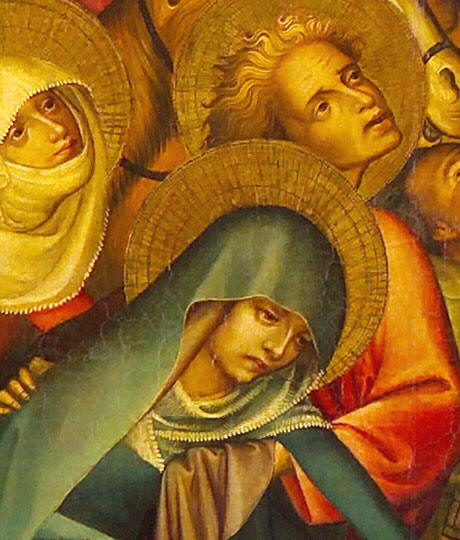









|
|
Sites
Artists
Other
Works
Medieval
frescoes
The
Coronation regalia

Chief medieval
sites of Hungary
Many of present-day Hungary's most important medieval
buildings were reduced to ruins during the Turkish wars between 1541-1689.
New churches and castles were built where the old ones once stood, and the
ruins of many other buildings were slowly forgotten. Starting in the
mid-19th century, archaeological research and other methods have slowly
started to reveal the fragments of these buildings. A summary catalogue of
Hungary's architectural fragments, published in 1988 (Lapidarium
Hungaricum - Magyarország építészeti töredékeinek gyüjteménye 1. Általános
helyzetkép, ed. by Miklós Horler et al, Budapest: 1988) listed 400
locations where altogether more than 60,000 fragments are kept, and the
number has kept growing since then. A great number of these fragments are
uncatalogued, and virtually unknown for the public, although these
fragments form the foundation on which the history of Hungarian medieval
architecture and sculpture can be built. With the Millecentenary and
Millenial Years (1996, 2000), a lot more attention has been paid to this
material, and many colections will be soon exhibited and catalogued. On
this page, I give a brief description of the most important such
collections.

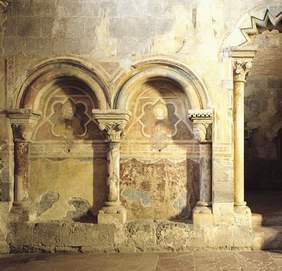
|
Esztergom
Former capital of Hungary (up to 1198)
and the seat of Hungary's primary archbishop, Esztergom played a
central role in Hungary's life. When the new cathedral church was
built at the beginning of the 19th century, the ruins of the old one
were completely torn down, and not much has remained of the adjacent
palace either. Remains of the palace were excavated in the 1930s, and
excavations on the Castle Hill and elswehere in town have continued
since then. Today at least 5000 carved stones are kept in various
temporary storage facilities in Esztergom. About 100 pieces are
exhibited in the Castle Museum, and about two dozen tombstones are in
the crypt of the Cathedral. Several more stone carvings have recently
been displayed in a new Lapidarium, opened inside the castle museum.
The Museum is housed in the former royal/archiepiscopal palace, which
has been rebuilt in 2000. The collection and the museum is officially
part of the Hungarian National Museum.
←Detail of the palace
chapel at Esztergom, with 14th century frescoes. |
|
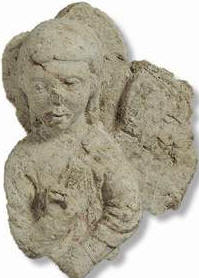
|
Budapest
With more than 20% of the countrywide
material, the Budapest History
Museum manages the largest collection of stone fragments
in Hungary, most of them coming from various exhibitions in the
territory of Budapest, including the Buda Royal Palace. The material
includes the fragments of the Buda Royal Palace, the church of Our
Lady in Buda, the Óbuda royal castle and churches, as well as material
from various other medieval churches in the territory of Budapest.
While some of the most important pieces are exhibited in the museum,
most are kept in various storage facilities scattered throughout the
city, and ongoing excavations keep enlarging the corpus. The most
important current excavations are the ones on Szent György Square in
the Buda Castle.
←Figure of an
angel from the Church of Our Lady in Buda |
|
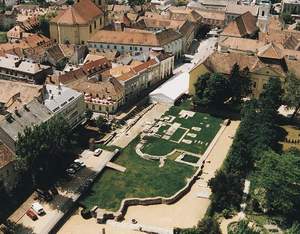
|
Székesfehérvár
Székesfehérvár is the site of the ruins
of the former royal basilica, Hungary's coronation church, and the
burial place of many kings. Essentially only the foundations survived,
along with countless fragments of architectural and sculptural
material. Excavations here have been going on since the middle of the
nineteenth century. Currently a new museum exhibition is being planned.
Most of the fragments are catalogued, but not yet published in detail.
←Aerial view of the site
of the royal basilica |
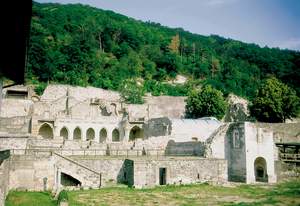
|
Visegrád The Visegrád Palace Museum, a unit
of the Hungarian National Museum has a large and ever-growing
collection of stones as well. Excavations in the Royal Palace are
still going on, revealing further material. Exhibitions inside the
palace and in the nearby Salamon tower provide adequate circumstances
for viewing the most important pieces of the collection. Much of the
material has been catalogued in the first Lapidarium Hungaricum
volume, and continuous publications ensure that this monument is
one of the better known ones in Hungary. The Royal Palace itself has
been reconstructed on a scale unimagined before.
←View of the Royal Palace
before the recent reconstruction |

|
Pécs
All of the medieval stone scultpure from the cathedral
of Pécs has been removed at the time of the nineteenth century
reconstruction. The material, Hungary's most important group of
Romanesque statuary has not been on view for decades. The Cathedral
Museum is now open, providing much-needed access to the material. A
new catalogue will make the material even more accessible. Meanwhile
it is not certain how the results of new excavations, which revealed
chapels by the cathedral and the remains of a building, identified as
the University of Pécs, will be shown.
←Resurrected figures from
the Cathedral of Pécs |
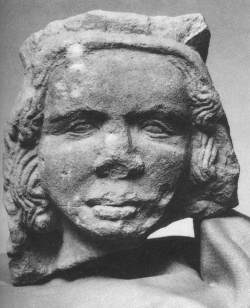
|
Pilis
Remains of the Cistercian Abbey of Pilis, an important
royal foundation, were excavated during the 1970s. Most of the
material is kept in various storage facilities at or near the site,
and the stones have recently been catalogued (not published). The most
important sculptural work - including the tomb of Queen Gerturdis and
the reconstructed choir screen - is exhibited at the Hungarian
National Gallery.
←Head from
the sculptural decoration of the Pilis choir screen |

|
Ják
The Benedictine Abbey Church of Ják is regarded as the
country's finest Romanesque building. The statues of the western
portal have deteriorated so much over the last century that it became
necessary to take them of, and replace them with replicas. The
original statues, as well as other material from the church will soon
be exhibited in a new museum built on the site.
←The central
figures from the western portal of Ják Abbey Church |

Medieval artists known by name
A handful
of medieval artists working in Hungary are known by name. Images of their
works can be seen on the Fine
Arts in Hungary website, Created by Emil Krén and Dániel Marx. The
following links will take you directly to the relevant sections of their
site.

Other chief works
The names of most medieval
artists are not known. The following list provides links to some of the most
important artworks from Hungary, and will continuously be updated.
The hoard of gold most likely belonged to an
Avar chieftan, and was hidden before the Conquest by the Magyars.

Medieval churches
In this section I would like to introduce a few medieval
churches from the territory of medieval Hungary, churches which are
well-documented on the web. Focus is on churches with medieval
wall-paintings.
 |
Gelence, a small frescoed church in Transylvania |
-Photos
of the church, with Quicktime virtual reality view of the interior
-A
complete overview of the church, with photos, a video and the complete
documentation of the painted coffered cealing from 1628 (site in
Hungarian. Select "Templomok" on the left, then "Gelence" from the
scroll-down menu)
 |
Velemér, a frescoes church in western Hungary.
painted by the workshop of Johannes Aquila |
-Photos
of the church, with Quicktime virtual reality views of the interior
 |
Photos and quicktime spherical panoramas of churches and
other monuments from the Carpathian basin, including several churches with
medieval frescoes
http://fenykeptar.karpatok.info/
Check out the following: |
Almakerék,
Csaroda
Gutor
Ócsa
Szalonna
Székelyderzs
Velemér
Vizsoly
and many others
|
